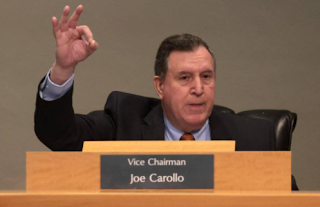Miami Herald: Redistricting plan splits Coconut Grove, Black residents lose
Redistricting plan splits Coconut Grove, Black residents lose
Miami Herald
Miami wants to dilute Black Coconut Grove’s political power just when it needs it most
Editorial BY THE MIAMI HERALD EDITORIAL BOARD
MARCH 03, 2022 6:33 PM
(Photo. Right) Joe Carollo gestures as he states that “zero” Black commissioners have ever been elected in District 2. Holland & Knight attorney and consultant Miguel De Grandy presented the preliminary redistricting plan at City Hall on Monday. CJUSTE@MIAMIHERALD.COM
Coconut Grove isn’t just Miami’s charming and oldest neighborhood. Its citizens are among the most politically engaged in the city — often a thorn on the side of some politicians.
The community, which was first settled by Bahamian pioneers more than a century ago and predates the city, is under threat of having its political influence diluted. At even higher risk is the political strength of the Grove’s historic Black community at a time when it’s fighting gentrification.
And the threat is coming from elected officials who should protect the area.
The City Commission is on the verge of approving new boundaries for its five electoral districts, which must be redrawn every 10 years when U.S. Census numbers come out. The new map would split the historic neighborhood into three districts, with some Black residents ending up in a mostly Hispanic district. That would be a big blow for a community that, through civic engagement, has seen success in maintaining its historic character and green areas.
Some commissioners have tried to spin this change as a good thing for the Grove, saying that being in three districts instead of one gives the Grove more power, not less. But they know better. Imagine having to go to three commissioners with different philosophies for help with neighborhood issues. Or hold three meetings each time you need to talk to your representatives.
CHANGING BOUNDARY LINES
All of the Grove currently sits in District 2, represented by Commissioner Ken Russell. The commission last Friday gave preliminary approval to a map that would slice off portions, with one piece in District 4, represented by Manolo Reyes, and another in District 3, represented by Joe Carollo.
Carollo stands to benefit the most from the new maps.
He moved out of his longtime home on Morris Lane in the Grove and into a West Brickell apartment to fulfill residency requirements to run in District 3 — which includes West Brickell — in 2017. After the election, his opponent filed a lawsuit alleging he didn’t actually live in his new apartment but a judge ruled in Carollo’s favor.
Now, under the new boundaries, District 3 juts out to cover Carollo’s house.
We don’t think that’s a coincidence. Grove residents have mobilized, gathering more than 1,800 online petition signatures and creating a group called One Grove. They are rightfully angry that the process has been rushed with few community meetings, and that the efforts to allow for public participation appear to be all for show, ahead of a final March 11 vote.
Map: Revised redistricting plan for City of Miami (right)OPPOSITION HAS HAD IMPACT
But their opposition did push the city’s redistricting consultant, attorney Miguel De Grandy, to reduce the total number of residents who would be moved from District 2 from almost 6,400 to 3,000, and the number of Black residents from nearly 500 to 114. While that’s progress, we must wonder what kind of representation those 114 Black residents will get in overwhelmingly Hispanic District 4.
District 2 covers most of Miami’s coastal neighborhoods stretching from Coconut Grove up through Morningside. It has seen the largest population growth in the past decade and, therefore, needs to shed residents so the city’s five districts can be comparable in size and population. But most of that growth occurred in the Brickell and downtown areas, not in the Grove.
Russell believes there’s an alternative to the three-way split of the Grove. He proposed a plan that would keep it intact, but slice off other parts of District 2.
“If we don’t have to tear [the Grove] up don’t tear it up,” Russell told the Herald Editorial Board.
Russell said he’s hopeful De Grandy will incorporate his proposal into the final map. De Grandy declined a request for an interview from the Board, saying the city has not authorized him to speak to the media.
HOW ABOUT MORE DISTRICTS?
Here’s another alternative: Miami’s population grew from just under 400,000 in 2010 to more than 442,000 in 2020. Maybe it’s time to create more districts. Tampa (population: 385,000) has seven council members. Atlanta (population: 499,000) has 12.
Russell wanted to ask voters to add new districts but the city commission shut that down. After all, why would elected officials dilute their own power to give voters better representation? That’s not how it works in Miami politics.
And yet diluting the Grove’s representation doesn’t seem to faze some of them. They cite communities like Shenandoah, which falls in both District 3 and 4. Some say Coconut Grove is seeking special treatment.
“There’s a group of activists from Coconut Grove who don’t want to be part of Miami,” Commissioner Alex Diaz de La Portilla said. But if “activist” is a bad word in his book, we don’t agree. An engaged citizenry is a good thing. It’s that attitude, though, that makes some residents skeptical that they will prevail.
One Grove attorney David Winker predicted to the Herald Editorial Board that the commission is likely to “jam this through.” His group would go to court if that happens, he added.
Before it reaches that point, though, the city should exhaust all its options to keep the Grove intact.
Miami Herald Editorial Board members are: Nancy Ancrum, editorial page editor; Amy Driscoll, deputy editorial page editor; and editorial writers Luisa Yanez and Isadora Rangel. Read more by clicking the arrow in the upper right.
Read more at: https://www.miamiherald.com/opinion/editorials/article258932613.html#storylink=cpy


Comments
Post a Comment